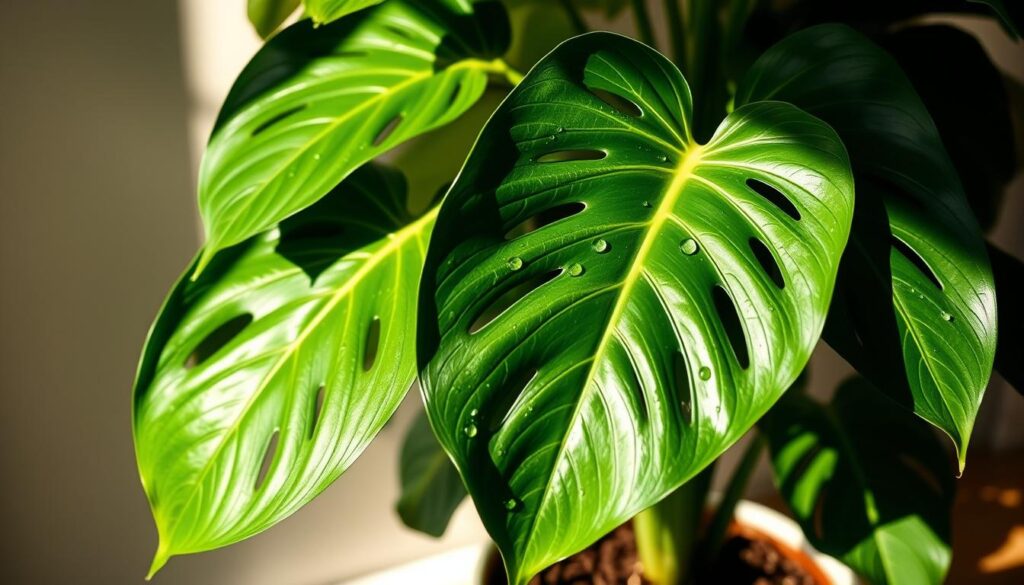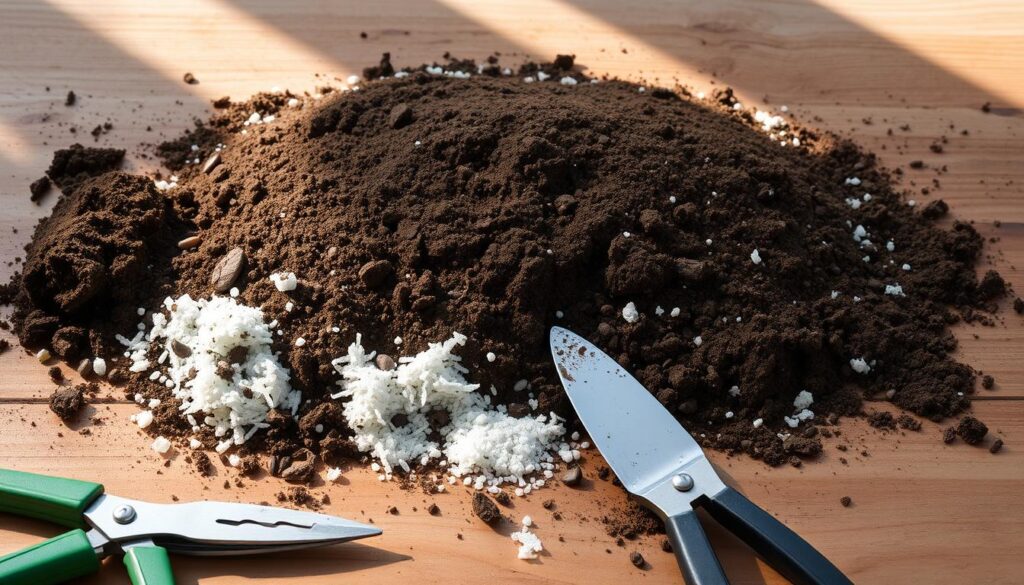
The Monstera Deliciosa is a stunning tropical houseplant known for its unique split leaves. Often called the “Swiss Cheese Plant” or “Split Leaf Philodendron,” it adds a touch of the exotic to any indoor space. Originating from the rainforests of southern Mexico and Panama, this plant thrives in warm, humid environments.
Understanding its natural habitat is key to providing the right conditions for healthy growth. With proper attention to watering, light, and soil, this plant can adapt beautifully to indoor settings. In this guide, I’ll share essential tips to help you nurture your Monstera Deliciosa and troubleshoot common issues.
Key Takeaways
- Monstera Deliciosa is a tropical plant with unique split leaves.
- It originates from the rainforests of southern Mexico and Panama.
- Common nicknames include “Swiss Cheese Plant” and “Split Leaf Philodendron.”
- Proper watering, light, and soil are crucial for healthy growth.
- This plant adapts well to indoor environments with the right care.
Introduction to Monstera Deliciosa
Known for its striking fenestrations, this plant brings a touch of the jungle indoors. Native to the rainforests of southern Mexico and Panama, it thrives in warm, humid environments. Its unique leaf holes, often called fenestrations, evolved to capture sunlight in dense forests. This adaptation allows it to grow efficiently even in low-light conditions.
The Swiss Cheese Plant is classified as an epiphyte, meaning it grows on other plants for support. It develops aerial roots that help it climb and absorb nutrients from the air. In the wild, it can reach heights of up to 66 feet, while indoors, it typically grows to about 9 feet.
| Environment | Height | Growth Habit |
|---|---|---|
| Wild | Up to 66 feet | Climbing with aerial roots |
| Indoor | Up to 9 feet | Bushy with occasional climbing |
While the leaves are mildly toxic if ingested, the ripe fruit of the Monstera Deliciosa is edible and has a sweet, tropical flavor. This fascinating plant is not only a visual delight but also a testament to nature’s ingenuity.
Monstera Deliciosa Care Indoors: The Basics

To ensure your plant thrives, it’s essential to replicate its natural habitat. Originating from tropical rainforests, this plant flourishes in environments with high humidity, filtered light, and good airflow. By mimicking these conditions, you can create an ideal setting for healthy growth.
Humidity plays a crucial role in keeping your plant vibrant. Aim for levels between 40-60%, which closely resemble its native environment. If your home is dry, consider using a humidifier or placing a water tray nearby to maintain moisture.
Light is another critical factor. This plant thrives in bright indirect light, similar to the dappled sunlight it receives under rainforest canopies. Avoid direct sunlight, as it can scorch the leaves.
One of the most fascinating features of this plant is its aerial roots. These roots, typical of epiphytes, help it climb and absorb moisture and nutrients from the air. To support this natural behavior, I recommend using moss poles. They provide vertical support and encourage the plant to grow upward, just like it would in the wild.
Finally, pay attention to the soil. Well-draining soil is a must to prevent root rot. Avoid compacted soil, as it can trap water and harm the roots. A mix of peat, perlite, and orchid bark works well to mimic the loose, airy texture of forest floors.
By understanding and replicating these natural conditions, you can create a thriving environment for your plant indoors.
Watering Your Monstera Deliciosa

Proper hydration is essential for maintaining the health and vibrancy of your tropical plant. Knowing when and how to water monstera can prevent common issues and promote robust growth. Let’s dive into the best practices for keeping your plant hydrated.
How Often to Water
I recommend checking the soil weekly to determine if your plant needs water. The top 2-4 inches of soil should feel dry before you water again. During the spring and summer, your plant may need more frequent watering due to active growth. In winter, reduce the frequency to avoid overwatering.
To gauge soil dryness, use the finger test or a moisture meter. Insert your finger into the soil up to the second knuckle. If it feels dry, it’s time to water monstera. For beginners, self-watering planters with drainage layers can simplify the process.
Signs of Overwatering and Underwatering
Overwatering can lead to yellow leaves and soggy soil, which may harm the roots. If you notice these signs, let the soil dry out completely before watering again. Improve drainage by ensuring your pot has adequate holes.
Underwatering, on the other hand, causes leaves to curl and the soil to become bone dry. If this happens, give your plant a thorough soak and adjust your routine. For more tips on maintaining the right moisture levels, check out this guide.
Light Requirements for Monstera Deliciosa
Understanding the light needs of your tropical plant is key to its thriving growth. Proper lighting ensures vibrant leaves and prevents issues like sunburn or leggy growth. Let’s explore how to provide the ideal light conditions for your plant.
Bright Indirect Light: What It Means
Bright indirect light mimics the dappled sunlight found in tropical forests. It’s not direct but still provides ample illumination. For example, placing your plant near a west-facing window with sheer curtains works well. This setup filters intense afternoon rays while maintaining brightness.
Rotating your plant every few weeks ensures even growth. This prevents one side from stretching toward the light source. If you notice leggy growth, it’s a sign your plant needs more bright indirect light.
Adjusting Light for Optimal Growth
If your space lacks natural light, consider using grow lights. Position them 12-18 inches above the plant for balanced exposure. For intense sunlight, sheer curtains are a simple solution to diffuse harsh rays.
In my experience, placing the plant about 10 feet from a west-facing window provides the perfect balance. This distance prevents leaf scorching while ensuring adequate brightness. Remember, every home is different, so observe your plant’s response and adjust accordingly.
Soil and Potting Needs

The right soil and potting setup can make all the difference for your plant’s health. A well-draining mix is essential to prevent waterlogging and promote healthy roots. I recommend using a chunky blend of peat, perlite, and orchid bark. This combination mimics the loose, airy texture of forest floors.
Drainage is critical. Always choose a pot with holes at the bottom. Pair it with a saucer to catch excess water. For added moisture retention, consider placing a layer of moss on the soil surface. It also adds a touch of natural beauty.
Choosing the Right Soil
The ideal soil should retain moisture without becoming soggy. Aeration stones at the bottom of the pot can improve drainage. Avoid compacted soil, as it can suffocate the roots. A well-balanced mix ensures your plant gets the nutrients it needs.
When to Repot
Repotting is necessary when the roots outgrow their container. I suggest doing this every 2-3 years, preferably in spring. Gradually size up the pot to avoid overwhelming the plant. If your plant looks sparse, consider adding propagated stems to fill the space.
| Task | Frequency | Tips |
|---|---|---|
| Repotting | Every 2-3 years | Use a slightly larger pot |
| Soil Check | Monthly | Ensure it’s loose and well-draining |
| Moss Layer | As needed | Retains moisture and enhances aesthetics |
Fertilizing Your Monstera Deliciosa
Feeding your plant the right nutrients is essential for its vibrant growth. Fertilization provides the necessary elements to support healthy foliage and robust development. Understanding your plant’s needs will help you create an effective feeding routine.
Choosing the Right Fertilizer
I recommend using a balanced liquid fertilizer with a 10-10-10 NPK ratio. This ensures your plant receives equal parts nitrogen, phosphorus, and potassium. These nutrients promote leaf growth, root development, and overall health.
Avoid over-fertilizing, as it can lead to salt buildup in the soil. This can harm the roots and stunt growth. Always dilute the fertilizer according to the instructions to prevent damage.
Fertilizing Schedule
During the spring and summer, feed your plant once a month. This aligns with its active growing season. I use SUPERthrive, diluting it in my watering can for easy application.
In fall and winter, pause fertilization. Your plant enters dormancy during these months and doesn’t require extra nutrients. Flush the soil annually to remove any excess salts and maintain a healthy environment.
By following this schedule, you’ll ensure your plant thrives year-round. Proper fertilization is a simple yet powerful way to support its growth and vitality.
Maintenance and Troubleshooting
Keeping your plant healthy requires regular attention and proactive measures. A well-maintained plant not only looks beautiful but also stays resilient against challenges. Let’s explore some essential practices to ensure your plant thrives.
Dusting and Cleaning Leaves
Dust can accumulate on leaves, blocking sunlight and hindering photosynthesis. I recommend wiping the dust leaves monthly with a DIY mix of water, neem oil, and dish soap. This solution keeps the foliage clean and deters pests.
For larger plants, use a soft cloth or sponge to gently clean each leaf. Avoid harsh chemicals, as they can damage the surface. Regular cleaning also allows you to inspect for any signs of stress or infestation.
Dealing with Pests
Pests like spider mites and scale can harm your plant if left unchecked. Inspect the leaves and stems regularly for tiny webs or sticky residue. If you spot any, treat the affected areas with insecticidal soap.
Neem oil is another effective remedy. It disrupts the life cycle of pests without harming the plant. For severe infestations, isolate the plant to prevent spreading. Consistent monitoring is key to keeping your plant pest-free.
Supporting heavy stems is another aspect of maintenance. Use stakes or moss poles to prevent tipping and encourage upward growth. My plant, Fran, recovered beautifully after staking, showcasing lush, healthy foliage.
Finally, boost humidity with pebble trays or humidifiers. This mimics the plant’s natural environment and keeps it vibrant. By following these tips, you’ll ensure your plant remains healthy and thriving.
Conclusion
Creating a thriving plant at home is easier than you think with the right approach. Focus on the essentials: proper light, consistent watering, well-draining soil, and adequate support. These pillars ensure healthy growth and long-term vitality.
Personalize your plant’s space with decorative touches like shells or rocks. These small details can enhance its aesthetic while complementing its natural beauty. Remember to adjust your routine with the seasons, as your plant’s needs may change throughout the year.
I’d love to hear about your plant journey! Share your stories and tips in the comments below. For more care tips, explore our guides on Pothos and Fiddle Leaf Fig care. Happy planting!
